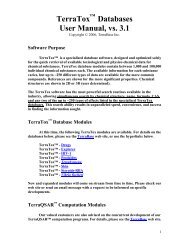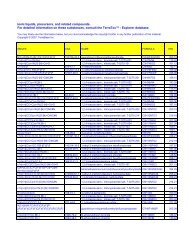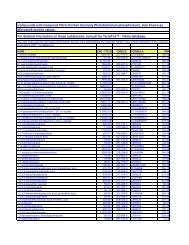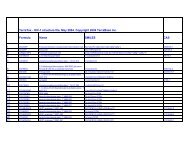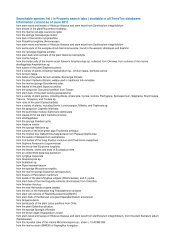Comparative Assessment of QSAR Models for Aquatic Toxicity
Comparative Assessment of QSAR Models for Aquatic Toxicity
Comparative Assessment of QSAR Models for Aquatic Toxicity
You also want an ePaper? Increase the reach of your titles
YUMPU automatically turns print PDFs into web optimized ePapers that Google loves.
It has to be pointed out that, while high leverage chemicals in the <strong>QSAR</strong> model training setrein<strong>for</strong>ce the model itself, the test chemicals with high leverage values greater than thewarning value have unreliable predicted data, being the result <strong>of</strong> substantial extrapolation <strong>of</strong>the model.Several other SIDS chemicals have unreliable predictions according to their leverage values(1,2,3-Propanetriol (S2), Ethene,chloro (S12), 2-Cyclohexen-1-one,3,5,5-trimethyl- (S18),1,6-Octadien-3-ol, 3,7-dimethyl (S19), 2-Propenamide (S23), 2-Pyrrolidinone, 1-ethenyl(S37), 1,2-Benzenedicarbonitrile (S43), Propanoic acid, 2-methyl-, anhydride (S54), 2-Propenoic acid, 2-ethylhexyl ester (S68), 2-Butenal, 3-methyl (S79), Cyclohexene (S90), 5-Hepten-2-one,6-methyl- (S92), 2-Propanol, 1,1'-oxybis (S93), 1-Propene (S96), 1,6-Octadien-3-ol, 3,7-dimethyl-, acetate (S99), Phenol, 2,6-bis(1,1-dimethylethyl)-4-methyl-(S115), 3,5,9-Undecatrien-2-one, 6,10-dimethyl- (S118), 2-Propenoic acid, butyl ester(S119), 1-Hexadecen-3-ol, 3,7,11,15-tetramethyl- (S126), 1,2,4-Benzenetricarboxylic acid(S127), 5-Isobenz<strong>of</strong>urancarboxylic acid, 1,3-dihydro-1,3-dioxo (S128), 2-Buten-1-ol, 3-methyl (S129), 1,4-Benzenediamine, N-(1,3-dimethylbutyl)-N'-phenyl- (S133), 1,3,5-Triazine-2,4,6(1H,3H,5H)-trione, 1,3,5-tris(2-hydroxyethyl)- (S135), HCFC 141b (S143),Cyclohexanol, 5-methyl-2-(1-methylethyl)-, [1R-(1alpha,2beta,5alpha)]- (S144), 2-Propenoicacid, 2-(dimethylamino)ethyl ester (S147), Cyclohexanemethanamine, 5-amino-1,3,3-trimethyl- (S149), 1,2,4-Benzenetricarboxylic acid, tris(2-ethylhexyl) ester (S152),Hexadecanoic acid, 2-sulfo-, 1-methyl ester, sodium salt (S155), 2H-Pyran, 3,4-dihydro-2-methoxy (S157), 2-Benzothiazolesulfenamide, N,N-dicyclohexyl- (S159), 2,6-Octadienal,3,7-dimethyl (S161), Benzene, 1,4-dimethyl-2-(1-phenylethyl)- (S163), Benzenepropanoicacid, 3,5-bis(1,1-dimethylethyl)-4-hydroxy-, methyl ester (S165), 1,4-Benzenedicarboxylicacid, bis(2-ethylhexyl) ester (S166), Cyclohexanamine, 4,4'-methylenebis[2-methyl- (S167),Benzene, bis(1-methylethyl)- (S171), Benzene, 1,1'-oxybis-, pentabromo deriv. (S174)).These are not displayed in Williams plot because their experimental toxicity values aremissing. These are outside the applicability domain <strong>of</strong> the model according to their leverageand thus their predictions are not reliable.Then 22 SIDS chemicals were identified as strong outliers (Formaldehyde (S1), 1,2-Propanediol (S3), Formamide, N,N-dimethyl- (S8), 2-Butanol (S21), 2-Propenoic acid, 2-methyl-, methyl ester (S32), 1,2-Benzenedicarboxylic acid, dibutyl ester (S35), Butanamide,N-(2-methylphenyl)-3-oxo- (S45), 1,2-Ethanediamine (S76), 2,4-Pentanediol, 2-methyl-(S78), 2-Propanol, 1-methoxy (S81), 2-Butyne-1,4-diol (S89), 1,2-Benzenediol (S103), 2,4-Pentanedione (S108), Acetic acid, butyl ester (S110), Phosphoric-acid-tributyl-ester- (S112),2-Propenoic acid, ethyl ester (S117), Acetic-acid-ethyl-ester (S120), 2-Propanol, 1-phenoxy(S132), Phosphonic acid, dimethyl ester (S137), 1-Propanol, 2-phenoxy (S156), Phenol,nonyl- (S169), Phenol, 4-nonyl-, branched (S177). These chemicals are outliers only in theY-response space, since they are inside the X-AD <strong>of</strong> the model: either their toxicity valuesare wrong or the model is lacking in some additional feature.Evaluation <strong>of</strong> predictive per<strong>for</strong>manceThe prediction capability <strong>of</strong> the model in terms <strong>of</strong> explained variance (Q 2 ext) and externalstandard deviation error <strong>of</strong> prediction (SDEP ext ), evaluated by including only those SIDS testdata with reliable predictions according to the leverage approach, is satisfactory.26



